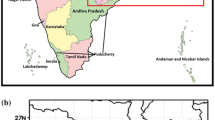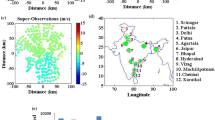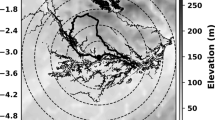Abstract
In this paper the impact of Doppler weather radar (DWR) reflectivity and radial velocity observations for the short range forecasting of a tropical storm and associated rainfall event have been examined. Doppler radar observations of a tropical storm case that occurred during 29–30 October 2006 from SHARDWR (13.6° N, 80.2° E) are assimilated in the WRF 3DVAR system. The observation operator for radar reflectivity and radial velocity is included within latest version of WRF 3DVAR system. Keeping all model physics the same, three experiments were conducted at a horizontal resolution of 30 km. In the control experiment (CTRL), NCEP Final Analysis (FNL) interpolated to the model grid was used as the initial condition for 48-h free forecast. In the second experiment (NODWR), 6-h assimilation cycles have been carried out using all conventional (radiosonde and surface data) and non-conventional (satellite) observations from the Global Telecommunication System (GTS). The third experiment (DWR) is the same as the second, except Doppler radar radial velocity and reflectivity observations are also used in the assimilation cycle. Continuous 6-h assimilation cycle employed in the WRF-3DVAR system shows positive impact on the rainfall forecast. Assimilation of DWR data creates several small scale features near the storm centre. Additional sensitivity experiments were conducted to study the individual impact of reflectivity and radial velocity in the assimilation cycle. Radar data assimilation with reflectivity alone produced large analysis response on both thermodynamical and dynamical fields. However, radial velocity assimilation impacted only on dynamical fields. Analysis increments with radar reflectivity and radial velocity produce adjustments in both dynamical and thermodynamical fields. Verification of QPF skill shows that radar data assimilation has a considerable impact on the short range precipitation forecast. Improvement of the QPF skill with radar data assimilation is more clearly seen in the heavy rainfall (for thresholds >7 mm) event than light rainfall (for thresholds of 1 and 3 mm). The spatial pattern of rainfall is well simulated by the DWR experiment and is comparable to TRMM observations.















Similar content being viewed by others
References
Abhilash, S., Das, S., Kalsi, S. R., Gupta, M. D., Mohankumar, K., George, J. P., Banarjee, S. K., Thampi, S. B., and Pradhan, D. (2007). Impact of Doppler radar wind in simulating the intensity and propagation of rainbands associated with mesoscale convective complexes using MM5-3DVAR system. Pure. Appl. Geo. Phys. 164, 1–19.
Arpe, K., Hollingsworth, A., Tracton, M. S., Lorenc, A. C., Uppala, S., and Kallberg, P. (1985). The response of numerical weather prediction systems on the FGGE level IIb data. Part 2: Forecast verifications and implications for predictability. Quart. J. Roy. Meteor. Soc. 111, 67–101.
Barker, D. M., Huang, W., Guo, Y. -R., Bourgeois, A., and Xiao, Q. (2004). A three-dimensional variational (3DVAR) data assimilation system for MM5: Implementation and initial results. Mon. Wea. Rev. 132, 897–914.
Black, T. L., Dimego, G. J., and Mesinger, F. (1999). A test of the ETA lateral boundary conditions scheme. In: Research Activities in Atmospheric and Oceanic Modelling, Ed. H. Ritchie. CAS/JSC Working Group on Numerical Experimentation, Report No. 28, WMO/TD-No. 942, p. 5.9–10.
Bhowmik, S. K. R., Roy, S. S., Srivastava, K., Mukhopadhay, B., Thampi, S. B., Reddy, Y. K., Singh, H., Venkateswarlu, S., and Adhikary, S. (2011). Processing of indian doppler weather radar data for mesoscale applications. Meteorol. Atmos. Phys. 111, 133–147.
Cheung, T. C, and Chan, P. W. (2010). Improving wind and rain simulations for tropical cyclones with the assimilation of Doppler radar data. Open Atmos. Sci. J. 4, 57–63.
Courtier, P., Thepaut, J. N., and Hollingsworth, A. (1994). A strategy for operational implementation of 4D-Var using an incremental approach. Quart. J. Roy. Meteor. Soc., 120, 1367–1387.
Crook, N. A., and Sun, J. (2002). Assimilating radar, surface, and profiler data for the Sydney 2000 forecast demonstration project. J. Atmos. Ocean. Technol. 19, 888–898.
Chung, K. -S., Zawadzki, I., Yau, M. K., and Fillion, L. (2009). Short-term forecasting of a midlatitude convective storm by the assimilation of single-Doppler radar observations. Mon. Weather Rev, 137, 4115.
Dai, A. G., Lin, X., and Hsu, K. L., (2007). The frequency, intensity, and diurnal cycle of precipitation in surface and satellite observations over low- and mid-latitudes. Clim. Dyn. 29(7–8), 727–744.
Das Someshwar., Abhilash, S., Das Gupta, M., George, J. P., Kalsi, S. R., Banerjee, S. K., Thampi, S. B., Pradhan, D., and Mohankumar, K. (2006). Assimilation of Doppler weather radar wind in a mesoscale model and their impact on simulation of thunderstorms and severe weather systems. Report no.NMRF/RR/01/2006, 120 pages, Published by NCMRWF, A-50, Institutional Area, Sector-62, NOIDA, India 201 307.
Doviak, R. J., and Zrnic, D. S. (1993). Doppler radar and weather observations,, 2nd edn. Academic Press, Orlando, 562 pp.
Downton, R. A., and Bell, R. S. (1988). The impact of analysis differences on a medium range forecast. Meteor. Mag. 117, 279–284.
Dudhia, J. (1989). Numerical study of convection observed during the Winter Monsoon Experiment using a mesoscale two dimensional model. J. Atmos. Sci. 46, 3077–3107.
Eilts, M. D., and Smith, S. D. (1990). Efficient dealiasing of Doppler velocities using local environment constraints. J. Atmos. Ocean. Technol. 7, 118–128.
Gao, J., Xue, M., Shapiro, A., and Droegemeier, K. (1999). A variational method for the analysis of three-dimensional wind fields from two Doppler radars. Mon. Wea. Rev. 127, 2128–2142.
Harrison, M. S. J., Palmer, T. N., Richardson, D. S., and Buizza, R. (1999). Analysis and model dependencies in medium-range ensembles: two transplant case studies. Q. J. R. Meteorol. Soc., 125, 2487–2515.
Hatwar, H. R., Subrahmanyam, V., Mohapatra, M., Roy Bhowmik, S. K., Bandyopadhay, B. W., Singh, C. H., and Srivastav a, K. (2008). A report on the cyclonic storm “Ogni” 2006, India Meteorological Department, Meteorological Monograph, Cyclone Warning Division 2/2008, 73 pp.
Hayden, C. M., and Purser, R. J. (1995). Recursive filter objective analysis of meteorological fields: Applications to NESDIS operational processing. J. Appl. Meteor. 34, 3–15.
Honda, Y., Nishijima, M., Koizumi, K., Ohta, Y., Tamiya, K., Kawabata, T., and Tsuyuki, T. (2005). A pre-operational variational data assimilation system for a non-hydrostatic model at the Japan Meteorological Agency: Formulation and preliminary results. Quart. J. Roy. Meteorol. Soc., 131, 3465–3475.
Hong, S. -Y., and Pan, H. L. (1996). Nonlocal boundary layer vertical diffusion in a medium-range forecast model. Mon. Wea. Rev., 124, 2322–2339.
Hu, M., Xue, M., and Brewster, K. (2006). 3DVAR and cloud analysis with WSR-88D level-II data for the prediction of the Fort Worth, Texas, tornadic thunderstorms. Part I: cloud analysis and its impact. Mon. Wea. Rev. 134, 675–698.
Huffman, G. J., Adler, R. F., Bolvin, D. T., Gu, G., Nelkin, E. J., Bowman, K. P., Hong, Y., Stocker, E. F., and Wolff, D. B. (2007). The TRMM multi-satellite precipitation analysis: Quasi-global, multi-year, combined-sensor precipitation estimates at fine scale. J. Hydrometeor. 8(1), 38–55.
Ide, K., Courtier, P., Ghil, M., and Lorenc, A. C. (1997). Unified notation for data assimilation: Operational, sequential and variational. J. Meteor. Soc. Japan, 75, 181–189.
Jorgenson, D. P., and Willis, P. T. (1982). A Z–R relationship for hurricanes. J. Appl. Meteor. 21, 356–366.
Krishnamurti, T. N., Gnanaseelan, C., Mishra, A. K., and Chakraborty, A. (2008). Improved forecasts of the diurnal cycle in the tropics using multiple global models. Part I: precipitation. J. Clim. 21, 4029–4043.
Liang, T. J., Carbone, R., Rutledge, S. A., Ahijevych, D., and Nesbitt, S. W. (2006). Regional radar composites version2, (http://radarmet.colostateedu).
Lindskog, M., Salonen, K., Jarvinen, H., and Michelson, D. B. (2004). Doppler radar wind data assimilation with HIRLAM 3DVAR. Mon. Weather Rev. 132, 1081–1092.
Lorenc, A. C. (1986). Analysis methods for numerical weather prediction. Q. J. R. Meteorol. Soc. 112, 1177–1194.
Lorenc, A. C., (2000). The Met. Office global threedimensional variational data assimilation scheme. Quart. J. Roy. Meteor. Soc. 126, 2991–3012.
Macpherson et al. (2003). Assimilation of radar data in numerical weather predicition (NWP) models. Weather Radar—Principles and Advanced Applications, P. Meischner, Ed., Springer, Berlin, pp 78–114.
Montmerle, T., Caya, A., and Zawadzki, I. (2001). Simulation of a midlatitude convective storm initialized with bistatic Doppler radar data. Mon. Weather Rev. 129, 1949–1967.
Montmerle, T., and Faccani, C. (2009). Mesoscale assimilation of radial velocities from Doppler radars in a preoperational framework. Mon. Weather Rev. 137, 1939.
Montmerle, T., Wattrelot, E., Faccani, C., Caumont, O., Jurasek, M., and Haase, G. (2007) Regional scale assimilation of radar data at Météo-France. Hirlam Tec. Report on Short Range numerical Weather Prediction.
Mohr, C. G., and Vaughan, R. L. (1979). An economical procedure for Cartesian interpolation and display of radar data to three dimensional space. J. Appl. Meteor. 18, 661–670.
Parrish, D. F., and Derber, J. C. (1992). The National Meteorological Center’s spectral statistical interpolation analysis system. Mon. Wea. Rev. 120, 1747–1763.
Purser, R. J., Wu, W. S., Parrish, D. F., and Roberts, N. M. (2003). Numerical aspects of the application of recursive filters to variational statistical analysis. Part I: spatially homogeneous and isotropic Gaussian covariances. Mon. Wea. Rev. 131, 1524–1535.
Ray, P. S., Ziegler, C. L., Bumgarner, W., and Serafin, R. J. (1980). Single- and multi-Doppler radar observations of tornadic storms. Mon. Wea. Rev. 108, 1607–1625.
Rennie, S. J., Dance, S. L., Illingworth, A. J., Ballard, S. P. and Simonin, D. (2011). 3D-Var assimilation of insect-derived Doppler radar radial winds in convective cases using a high resolution model. Mon. Weather Rev. 139, pp. 1148–1163.
Richardson, L. F. (1922). Weather prediction by numerical process. Cambridge University Press, Cambridge, 236 pp.
Richardson, D. S. (1998). The relative effect of model and analysis differences on ECMWF and UKMO operational forecasts. Proceedings of the ECMWF Workshop on Predictability, ECMWF, Shinfield Park, Reading RG2 9AX, UK.
Routray, A., Mohanty, U. C., Niyogi, D., Rizvi, S. R. H., and Osuri, K. K. (2010). Simulation of heavy rainfall events over Indian monsoon region using WRF-3DVAR data assimilation system. Meteorl. Atmos. Phys. 106, 107–125.
Skamaraock, W. C., Klemp, J. B., Dudhia, J., Gill, D. O., Barker, D. M., Wang, W., and Powers, J. G. (2005). A description of the Advanced Research WRF version 2, NCAR Tech. Note NCAR/TN-468_STR, 88 pp.
Srivastava, K., Bhowmik, S. K. R., Roy, S. S., Thampi, S. B., and Reddy, Y. K. (2010). Simulation of high impact convective events over Indian region by ARPS model with assimilation of Doppler weather radar radial velocity and reflectivity, Atmosfera, 23, 53–73.
Sugimoto, S., Crook, N. A., Sun, J., Xiao, Q., and Barker, D. M. (2009). An Examination of WRF 3DVAR radar data assimilation on its capability in retrieving unobserved variables and forecasting precipitation through observing system simulation experiments. Mon. Wea. Rev. 137, 4011–4029.
Sun, J., Chen, M., and Wang, Y. (2010). A frequent-updating analysis system based on radar, surface, and mesoscale model data for the Beijing 2008 forecast demonstration project. Weather Forecast. 25, 1715–1735.
Sun, J. (2005). Initialization and numerical forecasting of a supercell storm observed during STEPS. Mon. Wea. Rev. 133, 793–813.
Sun. J., and Crook, N. A. (2001). Real-time low-level wind and temperature analysis using single WSR-88D data. Weather Forecast. 16, 117–132.
Sun, J., and Crook, N. A. (1997). Dynamical and microphysical retrieval from Doppler radar observations using a cloud model and its adjoint. Part I: Model development and simulated data experiment. J. Atmos. Sci. 54, 1642–1661.
Sun, J., and Crook, N. A. (1998). Dynamical and microphysical retrieval from Doppler radar observations using a cloud model and its adjoint. Part II: Retrieval experiments of an observed Florida convective storm. J. Atmos. Sci., 55, 835–852.
Tai, S. -L., Liou, Y. C., Sun, J., Chang, S. -F., and Kuo, M. -C. (2011). Precipitation forecast using Doppler Radar data, a cloud model with adjoint, and the weather research and forecasting model – real case studies during SoWMEX in Taiwan. Weather Forecast. doi:10.1175/waf-d-11-00019.1.
Termonia, P., Deckmyn, A., and Hamdi, R. (2009). Study of the lateral boundary condition temporal resolution problem and a proposed solution by means of boundary error restarts. Mon. Weather Rev. 137, 3551–3566.
Wakimoto, R. M., Murphey, H. V., and Fovell, R. G. (2004). Mantle echoes associated with deep convection: Observations and numerical simulation. Mon. Weather Rev. 132, 1701–1720.
Waldteufel, P., and Corbin, H. (1979). On the analysis of single Doppler radar data. J. Appl. Meteorol. 18, 532–542.
Weygandt, S. S., Shapiro, A., and Droegemeier, K. K. (2002). Retrieval of model initial fields from single-Doppler observations of a supercell thunderstorm. Part I: Single-Doppler velocity retrieval, Mon. Weather Rev. 130, 433–453.
Xiao, Q., Kuo, Y. H., Sun, J., Lee, W. C., Lim, E., Guo, Y. R., and Barker, D. M. (2005). Assimilation of Doppler radar observations with a regional 3 DVAR system: Impact of Doppler velocities on forecast of heavy rainfall case. J. Appl. Meteorol. 44, 768–788.
Xiao, Q., Kuo Y. H., Sun, J., Lee, W. C., Barker, D. M., and Lim, E. (2007). An approach of radar reflectivity data assimilation and its assessment with the inland QPE of Typhoon Rusa (2002) at landfall. J. Appl. Meteor. Clim. 46, 14–22.
Xiao, Q., Lim, E., Won, D -J., Sun, J., Lee, W. -C., Lee, M. -S., Lee, W. -J., Cho, J., Kuo, Y. H., Barker, D., Lee, D. -K., and Lee, H. -S. (2008). Doppler radar data assimilation in KMA’s operational forecasting. Bull. Amer. Meteor. Soc., 89, 39–43.
Xiao, Q., and Sun, J. (2007). Multiple-radar data assimilation and short-range quantitative precipitation forecasting of a squall line observed during HOP_200. Mon. Weather Rev. 135, 3381–3404.
Acknowledgments
The authors are thankful to the Director, Indian Institute of Tropical Meteorology for providing necessary facilities to carry out this work. We also thank program manager, IITM HPC facility to carry out assimilation and forecast experiments in the HPC facility. We would like to thank the National Center for Atmospheric Research (NCAR), USA, in particular, Dr. Dale Barker for his immense assistance provided on the Mesoscale 3-DVAR assimilation system and to Dr. Mitch Moncrief for many stimulating discussions. Thanks are also due to the NCEP/FNL data provided by the Data Support Section (DSS) of the Scientific Computing Division at NCAR. The authors would like to acknowledge GSFC/NASA for making the TRMM data available in their web site. Authors are thankful to anonymous reviewers for comments and suggestions which helped improve the manuscript.
Author information
Authors and Affiliations
Corresponding author
Rights and permissions
About this article
Cite this article
Abhilash, S., Sahai, A.K., Mohankumar, K. et al. Assimilation of Doppler Weather Radar Radial Velocity and Reflectivity Observations in WRF-3DVAR System for Short-Range Forecasting of Convective Storms. Pure Appl. Geophys. 169, 2047–2070 (2012). https://doi.org/10.1007/s00024-012-0462-z
Received:
Revised:
Accepted:
Published:
Issue Date:
DOI: https://doi.org/10.1007/s00024-012-0462-z




